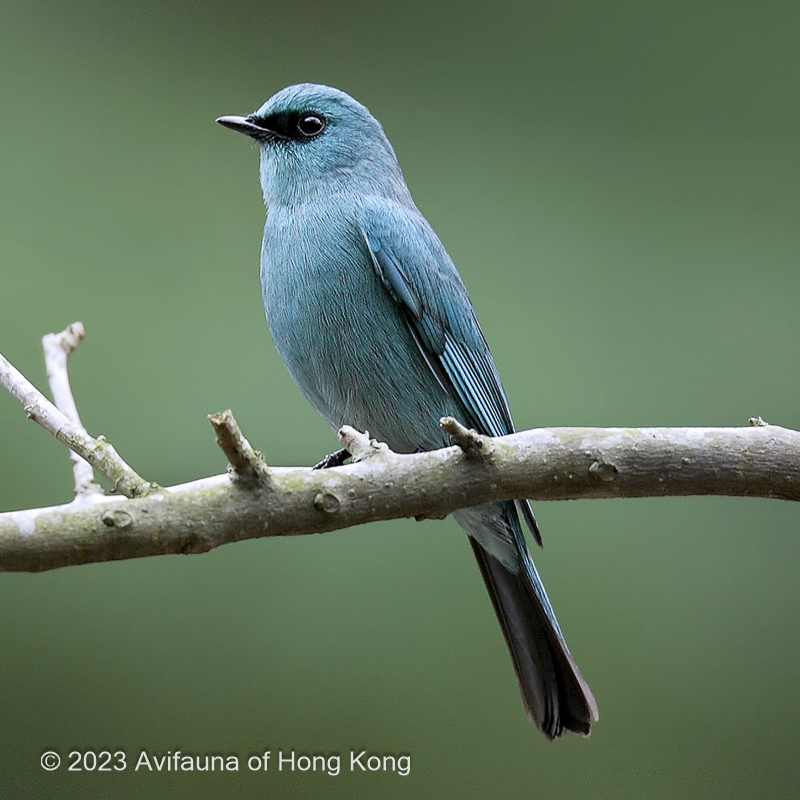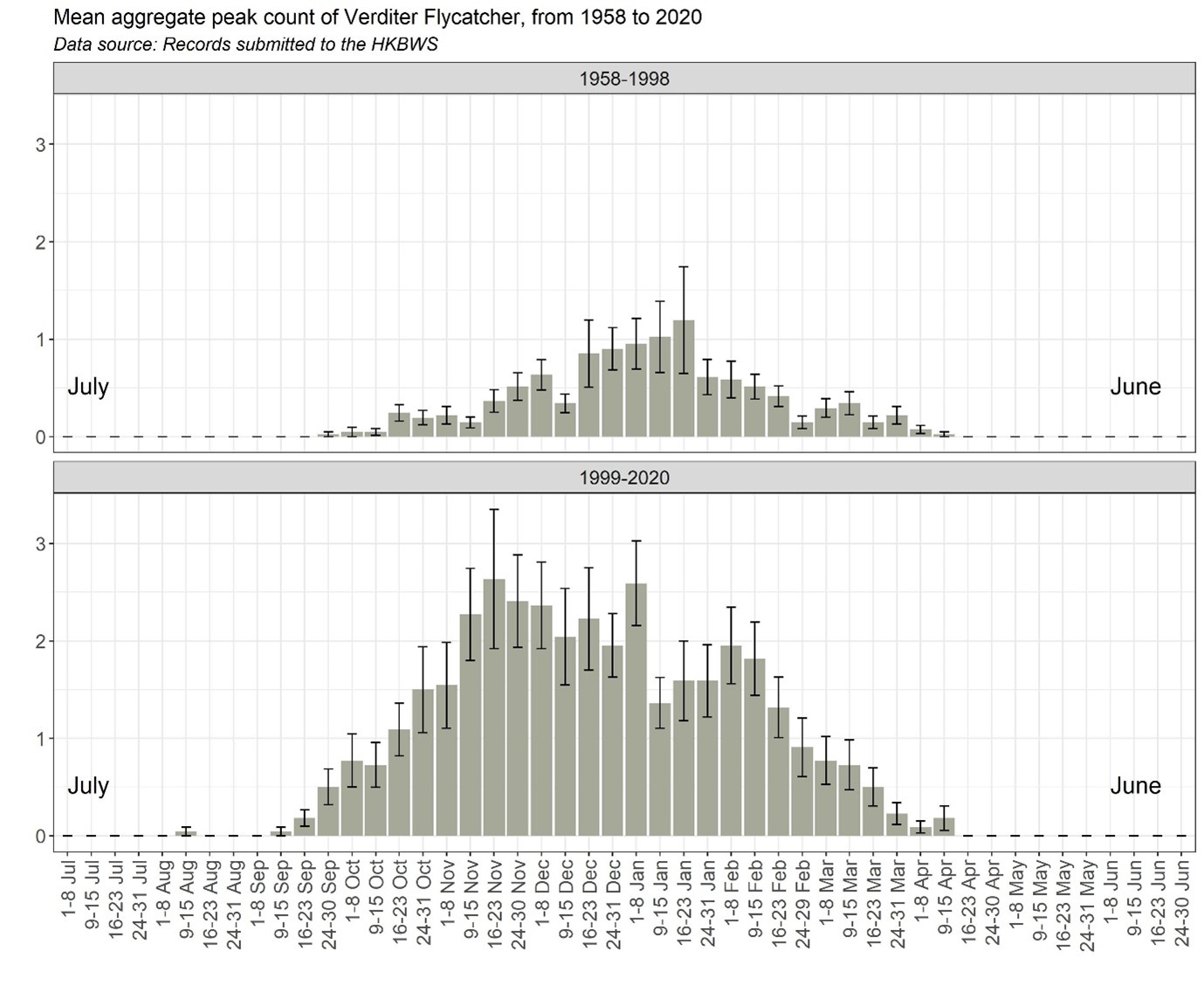Verditer Flycatcher Eumyias thalassinus 銅藍鶲
Category I. Uncommon winter visitor to closed-canopy forest.
IDENTIFICATION

Jan. 2010, Michelle and Peter Wong.
15-17 cm. The male is greenish blue with a brighter blue tail and upperwing. The lores are black. The undertail coverts have pale tips.

Dec. 2008, Michelle and Peter Wong.
The female is similar to the male but is slightly duller and has greyish lores. The chin and upper throat are finely barred greyish.
VOCALISATIONS
Appears to call rarely in HK. It can, however, give a short ‘tak’ call similar in tone to that of Dusky Warbler.
In spring the somewhat varied and rather rambling, moderately high but evenly-pitched song can occasionally be heard.
DISTRIBUTION & HABITAT PREFERENCE
Occurs largely in closed-canopy forest or forest edge, with many records from the Tai Mo Shan massif. Away from there, recorded at widespread sites in the New Territories, HK Island and the outlying islands. It occasionally occurs on passage at migrant sites such as Po Toi and Ho Man Tin but is predominantly a winter visitor.
OCCURRENCE
Verditer Flycatcher is an uncommon winter visitor and rare passage migrant to woodland areas, with extreme dates of 11 August and 15 April.
The sole August record occurred at Tai Po Kau in 2018 and concerned a bird of the year that had undergone substantial post-juvenile moult possibly indicating breeding near to HK. Verditer Flycatcher breeds in northern Guangdong, while the nearest known site may be Lianghua, about 85 km northeast of HK, where a juvenile was seen on 14 July 2018 (R.W. Lewthwaite in litt). Since then, there have been two further August records: one at Tai Lam Country Park on 25 August 2020 and one at Ho Man Tin on 29 August 2020.
Scarce in September and the first half of October, numbers increase after mid-October to the main period of occurrence from the second week of November to the second week of February (Figure 1) with peak occurrence in the first week of January. This differs from the pattern up to 1998 when the peak period of occurrence was December and January. Numbers decline from mid-February to early April, and there is a suggestion of weak passage in the second week of April, which is when most birds in song have been recorded.
Total winter counts were in single digits or very low double digits up until 2008/09 (Figure 2). Since 2009/10, however, all counts have been in double digits varying from 20 in 2013/14 to a high of 49 in 2018/19. These are the highest counts since the early 1970s when at least 24 individuals in total were noted in 1971. To a large extent this is probably due to a recent increase in observer activity.
It is usually reported in ones and twos. During the period under review, there were only three reports of three birds at a single site, and three reports of four. The highest count involved six at Lead Mine Pass on 26 February 2012. More recently, seven were at Pak Sha O on 7 November 2021. Groups of three or four were not uncommon in the early 1970s, but between 1985 and spring 2005 no more than two birds were recorded together. Birds may stay throughout the winter at favoured sites e.g., two were present at Shek Kong catchwater from 14 October 2016 to 20 March 2017.
Vaughan and Jones (1913) noted this species in spring at Macau, but the first records for Hong Kong were singles at Lam Tsuen on 6 February 1937 and 17 February 1940 (Herklots 1937, 1940).
BEHAVIOUR, FORAGING & DIET
Forages from fairly high and often exposed perches, such as bare trees, but also man-made artefacts in the form of posts and wires, especially late afternoon when it takes advantage of remaining sunlight. In the middle of the day, it is more likely to be seen in shady places and also in mixed-species foraging flocks below the canopy. It may feed on the ground in drainage channels during periods of cold weather. Males have occasionally been noted in song from 14 March to 15 April.
RANGE & SYSTEMATICS
E. t. thalassinus breeds from north Pakistan east to northeast India, central and south China, Myanmar, Thailand and Indochina, and winters south to central and southern India, Bangladesh, central Myanmar, central Thailand and southeast China. In China it breeds in much of south China south of the Yangtze floodplain (Liu and Chen 2020) but away from the south coast based on HK and Guangdong records. Winters in Guangdong, HK and Fujian (Clement 2020). E. t. thalassoides is resident in south Myanmar, south Thailand, Peninsular Malaysia, Sumatra and Borneo.
CONSERVATION STATUS
IUCN: Least Concern. Population trend stable.
Figure 1.

Figure 2.

Clement, P. (2020). Verditer Flycatcher (Eumyias thalassinus), version 1.0. In Birds of the World (J. del Hoyo, A. Elliott, J. Sargatal, D. A. Christie, and E. de Juana, Editors). Cornell Lab of Ornithology, Ithaca, NY, USA. https://doi.org/10.2173/bow.verfly4.01
Herklots, G. A. C. (1937). Notes and comments. Ornithology. Hong Kong Naturalist 8: 54-59.
Herklots, G. A. C. (1940). Notes and comments. Ornithology. Hong Kong Naturalist 10: 122-127.
Liu, Y. and Y. H. Chen (2020). The CNG Field Guide to the Birds of China (in Chinese). Hunan Science and Technology Publication House, Changsha.
Vaughan, R. E. and K. H. Jones (1913). The birds of Hong Kong, Macao and the West River or Si Kiang in South-East China, with special reference to their nidification and seasonal movements. Ibis 1913: 17-76, 163-201, 351-384.

